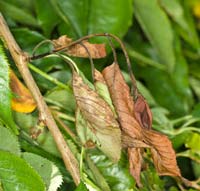New HDC Bacterial Canker Project
By Steve Roberts, 01 May 2014
Bacterial canker is a destructive disease of plums and cherries, that has been causing on-going problems for growers for many years. It can be caused by two distinct pathovars of Pseudomonas syringae: pv. morsprunorum (Psm) and pv. syringae (Pss). Psm is host specific to Prunus spp., whereas Pss has a much wider host range, with the potential for cross infection between a number of different species and genera. Although the stem canker phase is the most economically important, these pathogens may also cause leaf spots/shot-holes, shoot die-back and flower blights. An HDC-funded project on bacterial canker (HNS 179) has recently been completed, but was targeted specifically at improving disease management during nursery production, where the issues and control options differ from fruit production. This project aims to capitalise on the information and experience gained during the previous project to: (a) produce guidelines for disease control in fruit production; (b) determine if there is any evidence for the development of copper resistance in the UK as has occurred in the USA; (c) determine if there are any potential new or alternative products that have potential for use in disease control.
Tags: plants; diseases; bacteria; stone fruit; plums; cherries; bacterial canker
